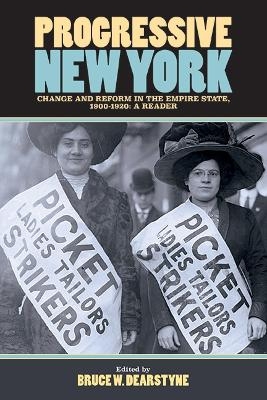
Progressive New York
State University of New York Press (Verlag)
978-1-4384-9737-2 (ISBN)
Progressive New York provides a firsthand portrait of one of the most exciting times in New York's and the nation's history: the progressive era, 1900–1920. This was a time of vast uncertainty and change—with major social and economic developments, including large-scale immigration, industrialization, and urbanization—roiling the nation. New Yorkers were among the first to confront and develop policies to deal with these issues. Political reformers made government more accountable; workers achieved shorter hours and better working conditions; social workers fought poverty and urban overcrowding; women achieved the right to vote; Black citizens advanced the cause of opportunity and equality; and, millions of immigrants enriched New York's culture. Drawing on accounts from contemporary newspapers, periodicals, books, and other sources, this collection introduces readers to the foundational ideas of the modern era. Among the authors are such influential figures as Emma Goldman, Alain Locke, Jacob Riis, Mary Beard, Abraham Cahan, W.E.B. Du Bois, and many others.
Bruce Dearstyne is the author of several books, including The Spirit of New York: Defining Events in the Empire State’s History) and The Crucible of Public Policy: New York Courts in the Progressive Era, both published by SUNY Press.
Acknowledgments
Introduction
Chapter 1. Gauging the Tenor of the Times
Extreme Wealth on Display
From The Reign of Gilt (1905) by David Graham Phillips
From "Drift" to "Mastery"
From Drift and Mastery (1914) by Walter Lippmann
Making Systematic, Incremental Progress
From The New Democracy (1912) by Walter E. Weyl
The Rising Standard of Living
From The City Worker's World in America (1917) by Mary K. Simkhovitch
The "Social Gospel" Fuels Progressivism
From Christianity and the Social Crisis (1907) by Walter Rauschenbusch
A Skeptical View of Modern Trends
From "A Layman's Views of an Art Exhibition," Outlook (1913) by Theodore Roosevelt
A Plea for Rural Values
From The Country Life Movement in the United States (1915) by Liberty Hyde Bailey
The Anarchist's Plea
From What I Believe (1908) by Emma Goldman
Chapter 2. Building Grand Enterprises
A Grand Expo in Buffalo
From Official Catalogue and Guide Book to the Pan-American Exposition (1901)
A New Cross-State Canal
From The Thousand-Ton Barge Improvement (1903) by Canal Improvement State Committee
New York City Opens Its Subway
From "Our Subway Open, 150,000 Try It," New York Times (October 28, 1904)
An Outstanding New Venue for Baseball
From "Ebbets Field Has No Rival in Baseball," New York Tribune (April 6, 1913)
Pioneering in Aviation
From "Flight Down the Hudson River from Albany to New York City," The Curtiss Aviation Book (1912) by Glenn Hammond Curtiss
A Grand New Train Station
From "New Grand Central Terminal Opens Its Doors," New York Times (February 2, 1913)
Technology and Innovation
From Book of the Kodak Exhibition (1912) by Eastman Kodak Company
Chapter 3. Reforming Politics and Government
Politics, Government, and "Honest Graft"
From Plunkett of Tammany Hall (1905) by George Washington Plunkett and William L. Riordon
"Muckrakers" Help Propel Progressivism
From "Concerning Three Articles in this Number of McClure's and a Coincidence That May Set Us Thinking," McClure's (1903) by S. S. McClure
Newspapers Expose Political Corruption
From New York Evening Post (January 18, 1910)
The "Treason of the Senate"
From "The Treason of the Senate: New York's Misrepresentatives," Cosmopolitan Magazine (March 1906) by David Graham Phillips
Direct Primaries
From "Message to the Legislature" (January 6, 1909) in Public Papers of Charles E. Hughes, Governor by Governor Charles Evans Hughes
A Day of Reform Triumph
From "Message to the Legislature" (December 8, 1913) in Public Papers of Martin H. Glynn, Governor by Governor Martin H. Glynn
From "All Glynn Bills to Pass This Week," New York Times (December 10, 1913)
New York's Progressive Party Presents an Aspirational Agenda
From State Platform, National Progressive Party of the State of New York Adopted by the State Convention, Syracuse, N.Y. Sept. 5, 1912 (1912) by National Progressive Party of the State of New York
Veering Away from Progressivism
From Revolutionary Radicalism (1920) by the Joint Legislative Committee Investigating Seditious Activities
Chapter 4. Improving People's Lives
Educating Young New Yorkers
From American Education (1909) by Andrew S. Draper
Revealing How Poor New Yorkers Live
From How the Other Half Lives: Studies Among the Tenements of New York (1901) by Jacob Riis
The Benefits of Tenement House Reform
From The Tenement House Problem (1908) edited by Robert W. DeForest and Lawrence Veiller
Charitable Assistance for New York's Poor
From Twenty-Sixth Annual Report for the Year Ending September 30, 1908 (1908) by the Charity Organization Society of the City of New York
Helping People Take Care of Themselves
From For You: It is Hard to Get Money, It is Harder to Spend it Right, Health is Wealth (1910) by Charity Organization Society of New York and New York City Tenement House Department
Settlement Houses and Visiting Nurses Ease City Life
From The House on Henry Street (1915) by Lillian D. Wald
Restricting Alcoholic Beverages
From "New York" in Proceedings of the Nineteenth National Convention of the Anti-Saloon League of America (1919) by William H. Anderson
Censorship Impacts Lives
From Anthony Comstock: Roundsman of the Lord (1927) by Haywood Broun and Margaret Leech
Strengthening Public Health
From Thirty Sixth Annual Report of the State Department of Health for the Year Ending December 31, 1915 (1915) by New York State Department of Health
Protecting Rural New York
From Powers and Territory of the New York State Troopers (1918) by Committee for State Police
Chapter 5. Strengthening Women's Status
Women Struggle for Equality in the Workplace
From A Woman of Fifty (1924) by Rheta Childe Dorr
Women Already Influence Public Policy; They Should Be Able to Vote
From "The Legislative Influence of Unenfranchised Women" (1914) by Mary Ritter Beard
Making the Case for Woman Suffrage
From "What Woman Suffrage Stands For" (1917) booklet by New York State Woman Suffrage Party
From "Twelve Reasons Why Women Should Vote" (1917) booklet by New York State Woman Suffrage Party
From "Modern Representative Government" (1917) booklet by New York State Woman Suffrage Party
From "Suffrage as a War Measure" (1917) booklet by New York State Woman Suffrage Party
Securing the Right to Vote
From Woman Suffrage and Politics: The Inner Story of the Suffrage Movement (1923), by Carrie Chapman Catt and Nettie Rogers Schuler
Women Can Vote, What Comes Next?
From "Now We Can Begin," The Liberator (1920) by Crystal Eastman
Public Support Encourages Women's Labor Activism
From "The Working Girls and Women of Rochester," The Common Good: An Independent Magazine of Civic and Social Rochester (1913) by Edwin and Catherine Rumball
Advocating for "Voluntary Womanhood"
From Woman and the New Race (1921) by Margaret Sanger
Chapter 6. Welcoming Newcomers
Immigrants Encounter New York
From The Rise of David Levinsky (1917) by Abraham Cahan
Adjusting to American Ways
From "The Making of an American," Outlook (1903) by David Blaustein
Aiding Immigrants
From "Solving the Immigration Problem," Outlook (1904) by Gino Carlo Speranza
Explaining the Immigrant Experience
From An American in the Making: The Life Story of an Immigrant (1917) by Marcus Eli Ravage
Documenting Immigrants' Challenges in New York
From Report of the Commission on Immigration of the State of New York (1909)
Asserting That Some Newcomers Are a Threat
From The Passing of the Great Race (1916) by Madison Grant
Defining New York's "Cultural Pluralism"
From "Democracy Versus the Melting Pot," The Nation (1915) by Horace M. Kallen
Chapter 7. Reckoning with Race
Probing Black New Yorkers' Burdens
From Half a Man: The Status of the Negro in New York (1911) by Mary White Ovington
An Outburst of Cultural Achievement
From The New Negro: An Interpretation (1925) by Allain Locke
Harlem Becomes a Center of Black Culture
From "Harlem: The Cultural Center," in Alain Locke, ed., The New Negro (1925) by James Weldon Johnson
New York's Racial Ambivalence
From "The Paradox of Color" in Alain Locke, ed., The New Negro (1925) by Walter White
Black Women Cope with Racism
From "The Double Task: The Struggle of Negro Women for Sex and Race Emancipation," Survey Graphic: Harlem Number 1 (1925) by Elise Johnson McDougald
The Push for Racial Justice
From The Crisis: A Record of the Darker Races (1910 and 1911) by W. E. B. DuBois
Chapter 8. Regulating Business
Regulation of Insurance Companies
From Report of the Joint Committee of the Senate and Assembly of the State of New York Appointed to Investigate the Affairs of Life Insurance Companies (1906)
A New Governor Sets a Progressive Tone
From "Inaugural Address" (1907) by Charles Evans Hughes
Asserting State Authority over Public Utilities
From "Governor Hughes," Outlook (1908) by Burton J. Hendrick
Lenient State Regulation
From "The Work of the Public Service Commission, Second District . . ." (1908) by Frank W. Stevens
Reigning In the New York-Led "Money Trust"
From Report of the Committee Appointed Pursuant to House Resolutions 429 and 504 to Investigate the Concentration of Control of Money and Credit (1913)
Chapter 9. Helping Workers
Industrial Morality and Social Progress
From Modern Industry in Relation to the Family, Health, Education, Morality (1914) by Florence Kelley
Ending Child Labor
"The City's Child Labor," New York Tribune, January 2, 1903
"Little Wage Earners," New York Tribune, February 13, 1903
From Tragedy to Action
From speech by Rose Schneiderman in The Survey (1911)
A Progressive Industrial Code
From Preliminary Report of the Factory Investigating Commission (1912)
Special Protection for Women Workers
From Women in the Bookbinding Trade (1913) by Mary Van Kleeck
Workers' Compensation for On-the-Job Injuries
From Report to the Legislature . . . by the Commission Appointed under Chapter 518 of the Laws of 1909 to Inquire Into the Question of Employers' Liability (1910)
Documenting the Harmful Effects of Long Working Hours
From Fatigue and Efficiency: A Study in Industry (1912) by Josephine Goldmark
Workers Take Direct Action
From "The Spirit of the Girl Strikers," Outlook (1910) by Miriam Finn Scott
Unions Advance Labor
From Organized Labor: Its Struggles, Its Enemies and Its Fool Friends (1904) by Samuel Gompers
Strong Unions Get Results through Collective Bargaining
From "Editorial: Manufacturers Plunged Cloak Industry Into War," The Ladies' Garment Worker (1916)
Chapter 10. Appealing to History
The "New History" Makes History More Relevant
From "The New History" in Proceedings of the American Philosophical Society (1911) by James Harvey Robinson
Putting History to Work for Progressivism
From An Economic Interpretation of the Constitution of the United States (1913) by Charles A. Beard
Public Pageants Boost New York History
From The Hudson-Fulton Celebration, 1909 (1910) by Herman Hagaman Hall
Students Need to Study History
From No Mummified History in New York Schools (1912) by Andrew S. Draper
Making American History More Engaging and Relevant
From Syllabus for the Secondary Schools (1910) by the State Education Department
History Should Aid Students' Social Development
From The School and Society (1915) by John Dewey
A New Departure for Higher Education
From A Proposal for an Independent School of Social Science for Men and Women (1919) by New School for Social Research
Writing a First Draft of History
From The Story of an Epochmaking Movement (1926) by Maud Nathan
Selected Bibliography
Index
| Erscheinungsdatum | 06.04.2024 |
|---|---|
| Zusatzinfo | Total Illustrations: 13 |
| Verlagsort | Albany, NY |
| Sprache | englisch |
| Maße | 152 x 229 mm |
| Gewicht | 227 g |
| Themenwelt | Sachbuch/Ratgeber ► Geschichte / Politik ► Regional- / Landesgeschichte |
| Geisteswissenschaften ► Geschichte ► Regional- / Ländergeschichte | |
| Sozialwissenschaften ► Politik / Verwaltung ► Staat / Verwaltung | |
| ISBN-10 | 1-4384-9737-7 / 1438497377 |
| ISBN-13 | 978-1-4384-9737-2 / 9781438497372 |
| Zustand | Neuware |
| Informationen gemäß Produktsicherheitsverordnung (GPSR) | |
| Haben Sie eine Frage zum Produkt? |
aus dem Bereich


